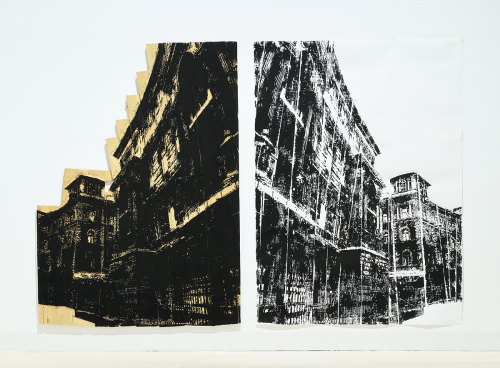A selection from the artworks added to the collection in 2016-2017 by purchase, donation, and as a long-term deposit of Ludwig Stiftung.

Work Probe / BLC 1.
The starting point for the installation is the so-called Bogen-Lipmann cage, an object to measure spatial-visual intelligence, which is used in career counseling even today.

Confrontation-action: Double portrait
László HARIS's Double Portrait was made in 1973, when his friend, Sándor Csutoros’ wife was sentenced to imprisonment without reason in a years-long medical lawsuit in Gyöngyös. Double Portrait shows the painted fingertips of the couple's thumbs, on a very large scale.

Handbook to the Stars
Péter PUKLUS’s work of book art represents the workings of the human brain by artistic means. The artist created a chart from juxtaposed photographs, which are connected via small points of contact, like the stars, which we can connect to form constellations.

Is it you, Joe? (Family)
Is It You Joe is a long-term project conceived in 2015. Joe is a fictional character who appears from time to time, unexpected, whenever it pleases him.

Ferenc K. - A Friendship
Ákos Birkás has been engaged with the genre of portrait and (self-)portrait since the beginning of his career. In the sixties, he tried to transcend the expected, realistic approach of the age with an existentially motivated, deeply experienced, personal portrait painting.

Albanian Stories
Adrian Paci made this video, simply recording his three-year-old daughter telling a series of improvised fairy tales, soon after he arrived with his family to Italy, taking refuge from the violent turn of events that shook Albania in 1997.

Japan (Flag of Virginity)
Japan is among Koja’s (Fitore Isufi) earliest videos. The flag, waving calmly under an almost hypnotic melody of Leonard Cohen’s the well-known Hallelujah, derides a local tradition long out of practice in the urban areas, still existing, however, in rural Kosovo.

Consumer Art 2.
The Polish Natalia Lach-Lachowicz assumed the name Natalia LL, which later became the trademark of her art in 1971, which was the time she made the first pieces of her Consumer Art series, which can be regarded as the first feminist artworks in Central Europe. There were many interpretations of t

Consumer Art 3.
The Polish Natalia Lach-Lachowicz assumed the name Natalia LL, which later became the trademark of her art in 1971, which was the time she made the first pieces of her Consumer Art series, which can be regarded as the first feminist artworks in Central Europe. There were many interpretations of t

My Name Their City 1-7.
Placing people bearing unusual names in the center of attention is a recurrent thread in Alban Muja’s work. The My Name Their City series seven Kosovan Albanian people, each of them positioned similarly, in a white, pure space with the photo of city-scape in their hands.
















